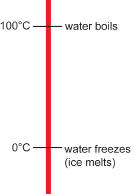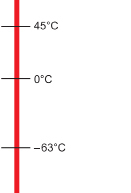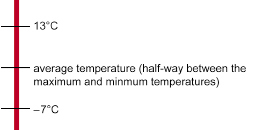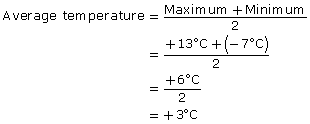Module 1
1. Module 1
1.24. Page 4
Module 1: The International System of Units (SI)
Bringing Ideas Together
Did You Know?
The Inuit have six words for snow. To travel in the Arctic, you need to know how various conditions can affect your travel by sled or by snowmobile.

Celsius: a temperature scale commonly used in every major country throughout the world, except the United States
The thermometer in the diagram gives temperature in degrees Celsius and Fahrenheit. The Celsius scale gives temperature readings in SI. In Lesson 5 of Module 2, you will explore the Fahrenheit scale.

The Celsius temperature scale is named after the Swedish scientist Anders Celsius, who invented a similar temperature scale in the 1740s. Anders Celsius divided the temperature difference between the boiling point of water and the temperature at which ice melts into 100°.
The modern Celsius scale is very similar in design. The freezing point of water is almost exactly 0°C, and the boiling point of water is almost exactly 100°C, so the two temperatures, for all practical purposes, are 100° apart.

Explore the interactive piece “The Celsius Scale” to reacquaint yourself with important benchmarks on the Celsius scale. Watch the thermometer level and the descriptors for different temperatures.
 Try This
Try This
Using the interactive “Real-World Benchmarks on the Celsius Scale,” place some familiar events or experiences along the appropriate position on the Celsius thermometer. When the event is dragged close to the appropriate spot, the event will snap into place.
You may decide to place a screen shot of your completed thermometer in your course folder for reference.
Temperature Measurements
In Iqaluit, Nunavut, the average daily temperature during the month of February is −26°C. In order to determine this average, someone had to perform calculations based on temperature measurements.
The following examples show some more contexts for calculations involving temperature measurements.
Example 1
The coldest recorded temperature in Canada is −63°C. This temperature was recorded on February 3, 1947, at Snag, Yukon. The hottest recorded temperature was 45°C on July 5, 1947, at Midale and Yellowgrass, Saskatchewan. What is the difference between these two temperatures?
Solution

The high temperature is 45 degrees above freezing. The low temperature is 63 degrees below freezing. The difference between these two temperatures is
45 + 63 = 108°C.
Another way to find this difference is to subtract −63 from 45.

Either method gives you the same result. A temperature of 45°C is 108°C warmer than −63°C. An interesting fact is that this difference is greater than the difference between the freezing point of water (0°C) and the boiling point of water (100°C); that difference is only 100 degrees.
Example 2
One day last spring, Ester recorded the maximum (highest) daily temperature on her farm. The maximum temperature was +13°C. The minimum (lowest) temperature was −7°C. What was the average temperature that day?
Solution

The high of +13°C is 20°C warmer than −7°C. So, the average temperature is 10°C colder than +13°C and 10°C warmer than −7°C. So, the average temperature was
13 − 10 = +3°C or − 7 + 10 = +3°C
Can you suggest another way of finding the average?

The average temperature on Ester’s farm was +3°C.
Temperature Differences
Use the interactive piece “Average Temperature and Temperature Difference” to confirm the temperature difference and average temperature calculated in the solutions of the previous examples. Just drag the sliders for the temperatures. You can also use the arrow keys to move the sliders.
 Self-Check
Self-Check
To complete this practice exercise, you will need access to the Internet. Do the following questions. When you are finished, check your answers.
SC 1. On September 5, 2009, at Beaverlodge, Alberta, the maximum temperature was 19.1°C and the minimum temperature was 3.7°C.
- Describe how you would dress for comfort at each temperature.
- What was the average temperature?
SC 2. What temperature should your refrigerator be set at to keep food from spoiling? Research your answer using the Internet.
SC 3. To what temperature should the interior of a hamburger be cooked before it is safe to eat? Research your answer using the Internet.
SC 4. What are the most common oven temperatures in degrees Celsius for baking? Research your answer using the Internet.
SC 5. When you are outdoors in winter, you will feel much colder in a strong wind than when the wind is calm. Environment Canada provides a chart for calculating wind chill on its website.
WIND CHILL FOR TEMPERATURES FROM +5 TO −20°C
V10 (km/h) |
Tair (°C) |
|||||
5 |
0 |
−5 |
−10 |
−15 |
−20 |
|
5 |
4 |
−2 |
−7 |
−13 |
−19 |
−24 |
10 |
3 |
−3 |
−9 |
−15 |
−21 |
−27 |
15 |
2 |
−4 |
−11 |
−17 |
−23 |
−29 |
20 |
1 |
−5 |
−12 |
−18 |
−24 |
−30 |
25 |
1 |
−6 |
−12 |
−19 |
−25 |
−32 |
30 |
0 |
−6 |
−13 |
−20 |
−26 |
−33 |
35 |
0 |
−7 |
−14 |
−20 |
−27 |
−33 |
40 |
−1 |
−7 |
−14 |
−21 |
−27 |
−34 |
45 |
−1 |
−-8 |
−15 |
−21 |
−28 |
−35 |
50 |
−1 |
−8 |
−15 |
−22 |
−29 |
−35 |
55 |
−2 |
−8 |
−15 |
−22 |
−29 |
−36 |
60 |
−2 |
−9 |
−16 |
−23 |
−30 |
−36 |
65 |
−2 |
−9 |
−16 |
−23 |
−30 |
−37 |
70 |
−2 |
−9 |
−16 |
−23 |
−30 |
−37 |
75 |
−3 |
−10 |
−17 |
−24 |
−31 |
−38 |
80 |
−3 |
−10 |
−17 |
−24 |
−31 |
−38 |
Credit: Wind Chill Calculation Chart. http://www.msc.ec.gc.ca/education/windchill/windchill_chart_e.cfm. Environment Canada, 2004. Reproduced with the permission of the Minister of Public Works and
Government Services Canada, 2009.
- What does the temperature feel like when the wind is 30 km/h and the outdoor temperature is +0°C?
- What does the temperature feel like when the wind is 40 km/h wind and the outdoor temperature is −15°C?
 Mastering Concepts
Mastering Concepts
Scientists often use the Kelvin (K) temperature scale. Zero (0 K) is absolute zero—the coldest possible temperature. It is also the temperature at which all molecular motion is at a minimum. The temperature 0 K is approximately −273°C.
Because degrees are the same size on both scales, the freezing point of water, or 0°C, must be 273 K. The formula for converting degrees Celsius to degrees Kelvin is K = °C +273.
For example, room temperature, or 20°C, would be

MC 1. Convert each of the following temperatures to degrees Kelvin:
- body temperature, 37°C
- the boiling point of water, 100°C
- a moderate oven temperature, 175°C